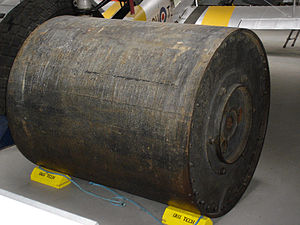
Back Скачучая бомба Byelorussian Bomba de rebot Catalan Rollbombe German Bomba de rebote Spanish Errebote-bonba Basque Bombe rebondissante French פצצה קופצת HE Bouncing bomb Italian 反跳爆弾 Japanese 반동 폭탄 Korean
| Vickers Type 464 code name: Upkeep | |
|---|---|
 "Upkeep" bouncing bomb at the Imperial War Museum Duxford | |
| Type | Conventional (depth charge) |
| Place of origin | United Kingdom |
| Service history | |
| In service | 16–17 May 1943 (Operation Chastise) |
| Used by | No. 617 Squadron RAF |
| Wars | World War II |
| Production history | |
| Designer | Barnes Wallis |
| Designed | April 1942 |
| Manufacturer | Vickers-Armstrongs |
| Produced | February 1943 |
| No. built | 120 (62 inert and 58 HE filled) 19 used operationally |
| Variants | Highball spherical bouncing bomb, inert training bombs |
| Specifications | |
| Mass | 9,250 lb (4,200 kg) |
| Length | 60 in (1.52 m) |
| Width | 50 in (1.27 m) |
| Muzzle velocity | 240–250 mph (390–400 km/h) 500 rpm back-spin |
| Effective firing range | 400–500 yd (370–460 m) |
| Filling | Torpex |
| Filling weight | 6,600 lb (2,990 kg) |
Detonation mechanism | hydrostatic fuze (depth of 30 feet (9.1 m)) with backup chemical time fuze. |
A bouncing bomb is a bomb designed to bounce to a target across water in a calculated manner to avoid obstacles such as torpedo nets, and to allow both the bomb's speed on arrival at the target and the timing of its detonation to be predetermined, in a similar fashion to a regular naval depth charge. The inventor of the first such bomb was the British engineer Barnes Wallis, whose "Upkeep" bouncing bomb was used in the RAF's Operation Chastise of May 1943 to bounce into German dams and explode underwater, with an effect similar to the underground detonation of the later Grand Slam and Tallboy earthquake bombs, both of which he also invented.
© MMXXIII Rich X Search. We shall prevail. All rights reserved. Rich X Search